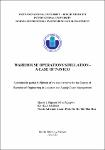| dc.description.abstract | One of the primary limitations in the field of warehousing pertains to the
efficient administration of warehouse capacity. The physical constraints of
warehouses encompass various factors, including the warehouse layout,
orientations, the quantity of dock entrances, the size of storage sites, and the
width of the aisles, among other considerations. The seasonality of storage
requirements may give rise to additional challenges. The optimization of
warehouse workflow and capacity necessitates the identification of the levels of
used capacity and the sequence of operations at which this occurs. The data can
subsequently be utilized to formulate a strategy for order acceptance by the
company, which can be implemented during both periods of low and high
demand.
The primary contribution of this thesis is the formulation of a series of
actions by the Maynard Operation Sequence Technique (MOST) and the
development of a Discrete Event Simulation (DES) model. These contributions
serve as a valuable foundation for addressing the inquiries. The primary
emphasis of this thesis centers around a case study that examines the operational
aspects of the NAVICO warehouse in relation to a significant customer who
exclusively deals with full pallet movements. The analysis of the model output
was conducted, resulting in the formulation of strategies aimed at enhancing the
performance of the NAVICO warehouse. | en_US |


